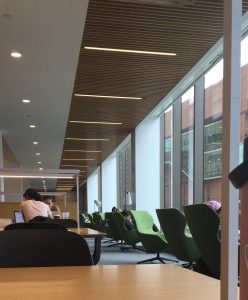
Barnard College Library. Photo Credit: Teresa Brown
At the end of September I had to choose a “second reader” for my thesis. In the History
department, all students writing a thesis attend a year-long thesis seminar course. In addition to the professor for this course, who leads the class, each student is required to seek out a second reader. The second reader is ideally another professor of history whose research interests are similar to that of the student’s and thus can function as a sort of expert in the field and faculty mentor.
Thanks to Sara’s earlier post, you now have some tips about how to write the dreaded
cold email to a professor to ask for their help. They’ve responded. Now what?
In choosing a second reader this past month and meeting with a few different professors, I have picked up a few tips for tackling your first (potentially zoom) meeting and making the most of the meeting.
First, let them know what you’re working on. When I was reaching out to professors in
search of a second reader for my senior thesis, I already had 15 pages worth of writing on my thesis topic. In addition to briefly summarizing your project in the body of the email, it can be helpful to attach a short excerpt of the work you have done so far or a detailed proposal. Sending along a short sample of your work gives the professor a sense of your writing style (this applies to STEM fields as well as humanities!) as well as where you are currently at in your project. That said, keep it brief. Professors are busy and don’t necessarily want to read everything you’ve written so far, especially if you are still in an early stage of your drafts. 10 pages (double spaced) is probably the maximum amount I would send to a professor for this purpose. Later in your process you will be able to send full drafts of your work. If you have some sort of outline or proposal of your project this can also be useful to send to professors as it provides a clear idea of what sources you have used, what you have learned thus far, what the aim of your project is and possibly even a work plan. This is a great way to provide a concise but comprehensive overview of your project.
Second, identify what type of advice you are looking for and communicate this prior to
your meeting. Are you looking for very specific edits to sentence structure? Looking for advice on restructuring the flow of the essay? Or are you earlier in the process and in need of recommendations for secondary sources to read? If you can identify exactly what advice is useful and communicate this to the professor well in advance of your meeting, they have time to prepare. You will get a maximum benefit because the feedback you receive will be more well thought out, and the professor is more likely to feel that their time is valued.
Third, plan to meet again. In this instance I don’t necessarily mean to suggest that you
both pull up your calendars and decide on an exact date and time. The specifics of scheduling are often better done over email where there is a written record of agreed upon meeting times. Rather, at the end of your meeting, share with the professor what your next steps will be. Name exactly how you will use their feedback, provide a rough estimation of where you will be in your process when you meet next and mention that you will reach back out to them when you are ready to meet again.
Of course, the last piece is follow-up. If you have a standing relationship with a professor
where you meet regularly, it is not necessary to send a thank-you-note every time. However, it is important to consistently follow-up with any questions that might arise after your meeting and to actually reach out about scheduling that next meeting.
